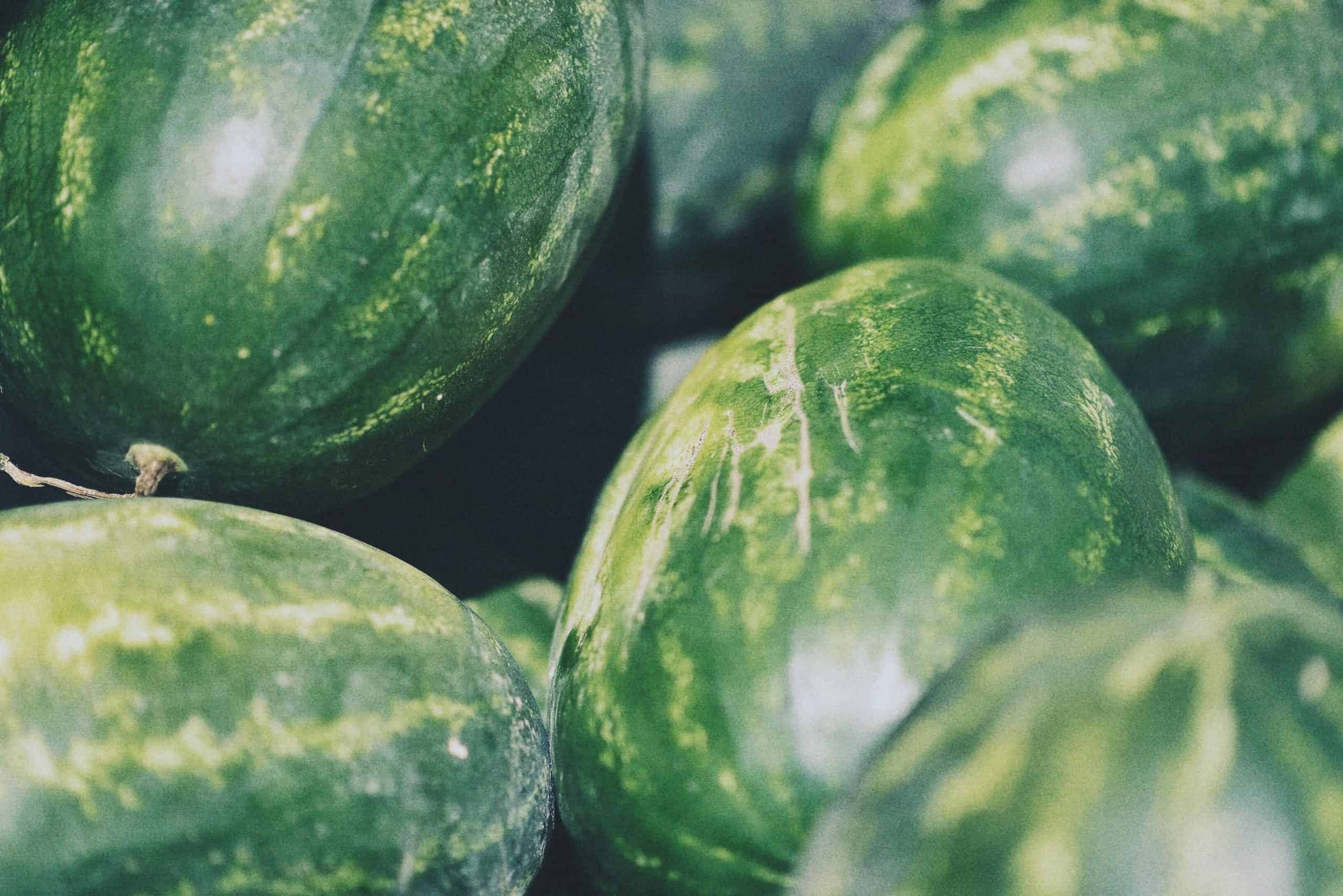We love to eat them but what about growing watermelon? Here’s how to grow watermelon successfully. Watermelons are annuals. This means their life cycle lasts for a year. You plant it, grow it, harvest it, and that’s that… meaning they die at the end of their growing season.
We’ve had success growing watermelons from seeds and starts and wanted to share what worked for us.
The fastest growing watermelon plants from seeds:
- Were in morning sun
- Had a minimum of 10 hours of sun/day
- Had 3 – 4″ of mulch after they were 2 – 4″ tall
These did far better than seeds we planted the same day which were in morning shade.
Continue reading for more tips on how to grow watermelon. We’ve grown watermelon in pots, in a garden bed, and in the ground.
The two most important things to know are:
- Watermelons require a lot of space to grow.
- Plan one variety of watermelon per every half acre you have. In many backyards, this means one type only. If you grow more varieties, they will cross-pollinate.
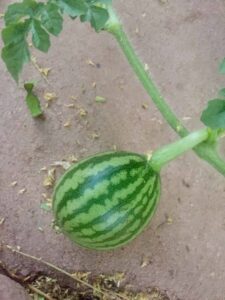
Where watermelons grow well
First off, it’s important to have a warm or hot summer to grow watermelon. Watermelons thrive in the heat.
On average, it takes between 70 – 90 days for watermelons to grow.
If you are a beginning gardener, it’s important to know your hardiness zone. This is one of the most important things to know about how to grow watermelon.
If you aren’t in the right hardiness zone, you won’t be able to grow watermelons well.
If you live in an area with a hardiness zone of 7 or above, you will be able to grow watermelons.
US Department of Agriculture hardiness zones are based on the average annual extreme minimum temperature.
The higher the minimum temperature, the higher the hardiness zone.
Watermelons grow best in zones 8 and above though there are varieties that can grow in zones 5 and higher.
Where watermelons don’t grow well
In order to find out what makes growing watermelons a success, it helps to know where they don’t grow well.
In the United States, areas it will be much more of a challenge to grow watermelons in the northern states.
Watermelon doesn’t grow well in hardiness zones 1 – 4.
If you are a beginning gardener, you won’t likely want to try growing watermelons if you have a hardiness zone of 6 or lower.
Watermelons will grow well in warmer climates in a sunny spot. Experienced gardeners may have some success in zones 3 – 5 with enough sun, proper soil, etc.
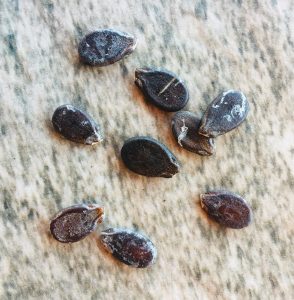
Growing watermelon from seeds and starts
We grow watermelons from seed as well as starts.
How to grow watermelon from seeds
Note, we never tried planting watermelon seeds from store-bought watermelons. There are mixed reviews on doing this.
Because we want to be successful, we’ve never tried drying out seeds from a watermelon we bought.
Instead, we buy organic watermelon seeds. We’ve had great success planting Crimson Sweet watermelon seeds and Tohono O’odham, a yellow watermelon variety.
How to grow watermelon from starts
Watermelon starts are small watermelon plants that are already started and growing. You buy them this way from the store.
There are usually one or two in the pot. You transplant them into your garden.
Watermelon varieties to plant
You can find watermelon seeds and watermelon starts at home improvement and hardware stores such as Ace Hardware, Lowe’s, and Home Depot as well as nurseries and garden centers.
While you will find many different varieties of watermelon seeds in the store, the watermelon starts there will be the varieties which do well in your area.
You can also ask at your local garden center or nursery.
Area with cooler summers
If you live in an area with cooler summer temperatures, you can still plant watermelon. When choosing watermelon seeds or watermelon starts, choose a short season variety.
You can start seeds indoors while it’s still cold outside. Transplant the watermelon plants outside two weeks after the last frost.
The ground needs to be at least 70 degrees F or 21 degrees C.
Area with hot summers
If you live in an area with summers higher than 90 degrees F (32.2 C) it’s also better to choose short season variety watermelons.
Short season variety watermelons
Some short season varieties of watermelons good to plant in home gardens are:
- Cole’s Early
- Sugar Baby
- Fordhook Hybrid

Remember, nurseries will be able to recommend what types of watermelon grows well in your area.
How to Grow Watermelon
Here are the steps for planting watermelons successfully.
1. Start in the spring
You must have the right watermelon planting season to grow watermelon.
Start seeds indoors. You should start them six weeks before transplanting.
Depending on your hardiness zone, this will likely be in February or March. In colder climates, this can be March or April.
The goal is to plant the starts two weeks after the last frost or later.
You can also plant seeds right into the ground at this time or later.
If you have a long summer or a late summer, you can wait until May to plant watermelon starts and seeds.
2. Decide where you will plant watermelon
Watermelon need space to grow. They do well planted right in the ground as well as in garden beds.
You can also plant watermelon in pots; however, they will vine around the pot and sprawl to the surrounding areas.
If you have the room to grow watermelon in pots, this can work well as the ground will keep them warm.
If you can plant watermelon in pots in an enclosed area on your property, as in a fenced backyard, this will help keep out critters as well.
Most importantly, watermelons need space. We planted watermelon seeds in two locations in pots on our property. In addition, we planted watermelon starts in a garden bed.
Plant one variety a growing season. If you have a property with several acres and have separate areas to grow watermelon, you can have more than one variety. Again, they must be a half an acre apart or more.
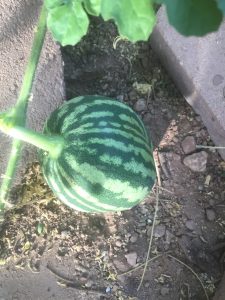
3. Consider the sun
Watermelons love full sun. We noticed major differences in growth between the watermelon seeds we planted in pots.
One had morning sun and sun throughout the day and grew fast early in the spring.
The other had early afternoon sun and was partially shaded by a tree. It was much more slow growing.
Watermelon needs as much sun as possible.
4. Buy watermelon seeds and/or watermelon starts
We plant watermelon seeds that we buy from the garden center, not ones from watermelons we eat.
Ask what watermelon variety grows well in your area.
In addition, we plant watermelon starts. We’ve had success with Crimson Sweet. They transplanted well into our garden beds.
5. Get quality soil
In order to grow, watermelon need well-draining soil. You should add organic fertilizer and compost if you have it.
If you are starting from scratch, you can purchase bags of commercial organic planting mix which will include what you need.
Put the soil in the garden bed or planters and get ready to grow watermelons.
6. Planting watermelon seeds and starts
You can’t plant watermelon until at least two weeks after the last frost. If it’s still cold but above freezing, you may want to wait a bit longer.
Watermelons do better when the ground is warmer.
Plant watermelon seeds
You can plant the watermelon seeds indoors in early spring to get them started. If it’s already after the last frost date, you can plant seeds directly into the ground.
Germination is approximately 10 – 14 days for most varieties.
Plant them 1″ (2.54 cm) deep into the soil.
Plant watermelon starts
Transplant your starts — either ones you grew or watermelon starts from the store.
Transplant into the ground, garden bed, or planters a few weeks after the last frost.
You can also plant watermelon from starts into May.
If you have summers that come later, you may plant them end of May or the beginning of June for them to harvest in September.
How far apart to plant watermelons
Whether from seeds or starts, you will want to have space between watermelon plants. In general, you should plant them 3 feet apart (.9144 m).
7. Water the watermelon plants
After you transplant the watermelon plants, you will need to water them. It’s important watermelons get enough water to grow.
A general rule is 2″ (5 cm) of water per week. If you live in a drier climate, they will require more.
As the summer progresses, you will want to increase watering. However, once there is fruit growing on the vine, you should decrease watering to make the watermelon sweeter.

It’s important to be consistent with your watering as well. For example, water in the morning or in the evening.
8. Mulch
We’ve had great success with putting mulch around the watermelon plants. Mulch works wonders to keep the soil moist which is what you need to grow watermelon.
We buy a big bale of alfalfa and use it all year, putting more around the watermelon plants as the spring and summer progress.
Personal note: We had noticeable growth in 24 hours after we added more mulch to our watermelon plants. Noticeable growth! It was amazing.
Mulch will help retain moisture as well as protect the roots from the sun. This is particularly important if you live in a hot climate.
Keep the mulch away from the stems.
Surround the plants with mulch — thicker surrounding the watermelon plants and lighter-to-none as you get close to the stem.
We pile mulch 3 – 4″ (8.89 cm) high surrounding the plants.
9. Pollination
It’s exciting to see flowers growing on the watermelon plants. However, unlike other plants, such as tomatoes, a flower doesn’t mean there will be a watermelon.
Generally, you will be able to grow 2 – 4 watermelons per plant.
The flowers early on are the male flowers. They will pollinate the female flower. It helps to have other flowers nearby to attract bees.
You may need to hand pollinate yourself. Do this first thing in the morning.
Tips for growing watermelon
We’ve grown watermelon from seeds and watermelon from starts.
I wanted to share our experience growing watermelons because we noticed how some of our watermelon seeds thrived and grew much faster than other watermelon seeds we planted the same day.
As stated above, the more sun the watermelon had, the better.
The slow-growing watermelon seeds — planted the same day — had:
- Shaded by a tree; no sun until noon
- Sun lasting for 6 – 7 hours
Mulching also made a big difference.
When we added thicker mulch to the already-fast-growing watermelon plants, they grew noticeably in days.
They quickly grew to the size of the watermelon starts and then surpassed them.
Watermelon companion plants
Watermelons are easy to grow if you are in a good hardiness zone. When you consider watermelon companion plants, do not plant them with potatoes.
The best plants to grow with watermelons are bush beans, pole beans, kale, okra, spinach, lettuce, cabbage, Brussels sprouts, broccoli and cauliflower.
Watermelons are compatible plants.
Just know they vine out and will continue sprawling. Give them the space they need. It’s not necessary to plant anything with them.
Growing watermelon in a pot
You can grow watermelon in a pot. Plant one start per pot or 3 – 4 watermelon seeds.
If you are growing from seeds in a pot, and they all start growing, snip the tops off the smaller one.
You can use tall pots or short pots. What’s most important is the area surrounding the pots. The watermelon will vine and sprawl around the pot.
You will want to be sure there is room for them to keep growing.
We like growing watermelon in containers because we can keep them in an enclosed area, away from wildlife.
You may also want to grow watermelon in pots if you live in an area with cooler summers. In this way, they can sprawl on concrete or a warm surface.
How long does it take for watermelons to grow
How long does it take a watermelon to grow will depend on if you buy a watermelon start or if you grow watermelon from seed.
Buying a watermelon plant from a garden center, nursery, or hardware store will give you a bit of a head start.
On average, watermelons take a minimum of 80 days to grow until harvest. There are some early varieties that grow in 65 days.
When to pick watermelon
It’s critical to harvest watermelon when it’s ripe and not before.
While watermelons in grocery stores are harvested early, you have the ability to pick them at the ideal time at home.
Watermelons will start to look dull when they are ready to harvest. Prior to this time, they may look glossy, shiny, or powdery.
Another way to tell when it’s ready to harvest is to gently turn the watermelon over and check the color on the part of the watermelon that rests on the ground.
If it’s white, it’s not ready to pick. If it’s a yellow, it’s ready.
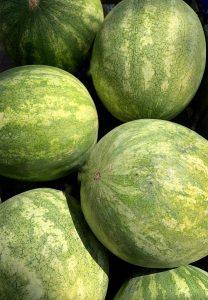
Growing watermelon from seed
We’ve read a lot about how difficult it is to transplant a watermelon plant. However, we have done this successfully.
We bought some plants as well as grew several from seed… both of which we transplanted… meaning we didn’t plant the seed right in the ground/pot.
When we grew watermelon from seed, we started it right in the ground or in pot. We didn’t start it indoors.
How many watermelons do you get per plant
You should be able to grow 2 – 4 watermelons per plant.
How to grow sweet watermelon
While watermelons will do well in many hardiness zones, they still need months to grow. In general, warmer climates will produce sweeter watermelon.
Areas with cooler summers will grow watermelons that aren’t as sweet.
Watermelons thrive in areas that are humid as well as semi-arid.
How to grow sweeter watermelon
Once the watermelons start to grow, give them less water in order to maximize sweetness.
Insects on watermelon plants
We had far less insects on our watermelon plants when we planted them in our pots or raised beds rather than directly in the ground.
We no longer plant them in directly in the ground for this reason; we only use a garden bed and pots.
Because we aren’t using chemical fertilizers, we weren’t able to organically control the pests when we planted them in the ground.
For organic gardening, you can use Bacillus thuringensis to treat insects.
When we grew them in large pots, we hardly had any insects.

However, growing them in pots posed greater challenges as our pots were far off the ground.
Watermelon plant flowers
You will see lots of flowers on your watermelon plants. However, not all of these will turn into watermelons.
There are male flowers and female flowers.
The male flowers will emerge first and will be a bit smaller. There will be more male flowers than female flowers.

The female flowers are the ones that will grow watermelons.
What is the best month to plant watermelon
April is the best month to plant watermelon. However, this answer really depends on your hardiness zone.
If you live in an area in which summer comes later, the best month to plant watermelon is May or early June.
Spring is the best time to plant watermelon. You will avoid frost, and the ground will be warm enough to grow watermelons.
Eating homegrown watermelons
It’s a great feeling to grow watermelon. Eating it, of course, is the best part.
While you won’t want to share your homegrown watermelons with many, a common question is if dogs can eat watermelon.
They can if it’s cut into small pieces. Be sure to remove seeds and any rind.
Because watermelon is hydrating, it’s best to give it on hot days to help with water intake or for an occasional treat.
You worked hard! To make full use of the watermelons you grew. If you have chickens, feed them the rinds. You can also compost watermelon rinds.
Growing watermelon
While they will thrive more in some areas, by tending to their needs, you should be able to grow watermelon.
The biggest requirement is to have a warm or hot summer.
It’s fun planting and growing watermelons at home. Use these tips on how to grow watermelon. It’s the ideal fruit for summer…. growing it yourself makes it even more delicious!

